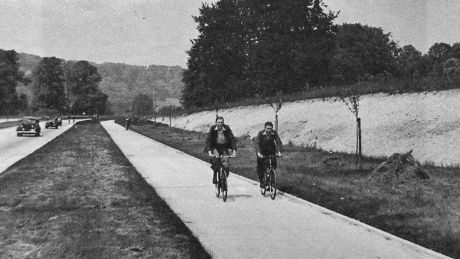There Are At Least 280 Miles Of Dutch-Style Cycleways In Britain That Have Been Forgotten
And there’s a Kickstarter campaign to bring them back into use

Despite the blindingly obvious benefits of getting more people out of cars and onto bikes, cyclists have to fight tooth and nail for every scrap of Tarmac reserved for those on two wheels.
Chief among the reasons for this lack of generosity is a perceived lack of space, but in the 1930s Britain had a very different attitude. Between 1937 and 1940 the Ministry of Transport encouraged the building of cycleways by only giving grants to local authorities to build arterial roads if they included 9ft-wide (2.75m) protected cycle paths on both sides.
At least 280 miles of cycleways were built and – put something soft on the desk in front of you because your forehead is about to meet it – a lot of them still exist but simply aren’t considered cycleways. They’re used as service roads or have fallen into disrepair, and they’re often left unmarked on maps.
All this information has been published by author Carlton Reid and transport planner John Dales as part of a Kickstarter campaign to get these cycleways back up and running.
Reid told Coach that he discovered the lost cycleways while researching his new book, Bike Boom.
“The book is about transportation cycling from 1905 to 1980 and for the chapter on the 1930s I uncovered more cycleways than I thought existed,” he says.
“While poring through the National Archives I found Ministry of Transport (MoT) correspondence that showed the ministry reached out to its Dutch counterpart in 1934 and was provided with plans to start building its own Dutch-style cycleways.
Sign up for workout ideas, training advice, reviews of the latest gear and more.
“The MoT planned to build 500 miles of them by 1940 – I have found evidence for 280 miles of them so far. More will be uncovered. Some are buried, others are hidden in plain sight, and nobody has so far identified them for what they are.”
Reid and Dales’s campaign has already met its £7,000 funding goal but will remain open until Thursday 25th May.
“The Kickstarter campaign aims to raise cash to carry out more historical research but also, and critically, submit reports to local authorities, Highways England and the Department for Transport so those cycleways which can be meshed into modern networks are brought back into use,” says Reid.
“The hard graft of re-signing them, perhaps resurfacing them, and improving treatments at junctions can only be done by official bodies. But we’ll be giving them the basic information to, hopefully, carry out that work.”
One important aspect of the campaign is that it demonstrates that even in built-up areas around London and Manchester – where old cycleways have been found – claims that there isn’t space for cyclists are unfounded.
“We’ve shown the space for cycling is there, and it’s been there for more than 80 years,” says Reid.
To check out the campaign head to the Kickstarter page. For more info on Bike Boom, which will be published by Island Press in June, visit bikeboom.info.

Nick Harris-Fry is a journalist who has been covering health and fitness since 2015. Nick is an avid runner, covering 70-110km a week, which gives him ample opportunity to test a wide range of running shoes and running gear. He is also the chief tester for fitness trackers and running watches, treadmills and exercise bikes, and workout headphones.
